10+ Things to Make With Violets
Here are a dozen pretty and practical ways to use violet flowers and leaves. I’ve also included a handy Violet Plant Spotlight printable that you can use as a reference sheet when working with violets.

Violets (Viola odorata, V. sororia) are not only lovely to look at, but are cooling and healing.
The leaves and flowers are edible food herbs and are traditionally used in fighting eczema, chronic diseases, and oral or breast cancer.
A few studies of interest (there are more to explore in Pubmed!):
Before You Begin
Make sure you have the right kind of violet that you’re using in these projects!
African violet houseplants are not related or edible/medicinal and should not be used in any of these recipes.
Here is an article I wrote about foraging violets:
Foraging Violets: How to Identify, Harvest & Use!
And did you know that you can grow your own violets from seed, if you don’t have any growing near you?
Find out how in this article I wrote at Unruly Gardening (my family’s gardening and foraging website):
Here’s a free printable about using violet flowers and leaves that I gave to a newsletter subscribers in the past. This year, I decided to slowly start adding my printables to the website, so everyone can access them at any time!
(Feel free to print out copies and share with youth or scout groups, garden clubs, etc. Just don’t try to sell them – they should stay free for everyone!)
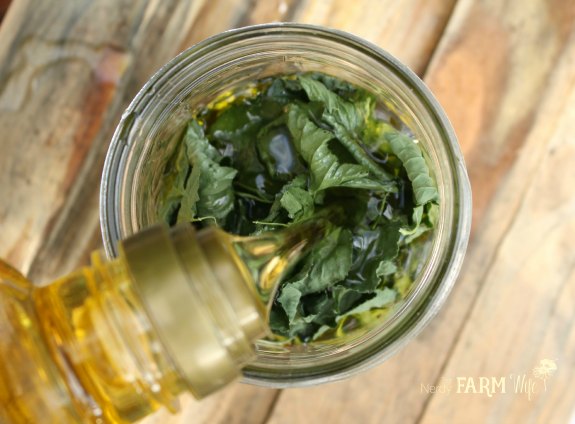
1. Violet Leaf Infused Oil
This violet leaf infused oil can be massaged directly onto dry, irritated skin or used as an ingredient in recipes for salves, lotions, creams, lip balms, soaps, and lotion bars.
Shelf life of strained infused oil is around 1 year.
If you don’t have violet leaves where you live, you can purchase dried from Mountain Rose Herbs.
To make it, fill a canning jar about half-way with dried violet leaves. Cover with about twice as much as your favorite carrier oil, or to the top of the jar. (Suggested oils include sunflower, olive, sweet almond, apricot kernel, avocado, hemp, and so forth.)
For a quick infusion: Set the uncovered jar down into a small saucepan filled with a few inches of water. Heat over a low burner for a few hours, keeping a close eye that the water doesn’t evaporate out. Remove from heat and strain. The quick infusion is the best way to infuse coconut oil.
For a slower, more traditional infusion: Cap the jar of dried violet leaves and oil and tuck away in a cabinet for around 4 to 6 weeks, shaking occasionally as you remember to. When the infusing time has passed, strain.
For an alternative option: You could also set the jar of violet leaves and oil in a sunny windowsill for several days to a week to jump start the infusion. (Don’t store for long periods in sunlight though, as it tends to fade flowers and herbs over time.)
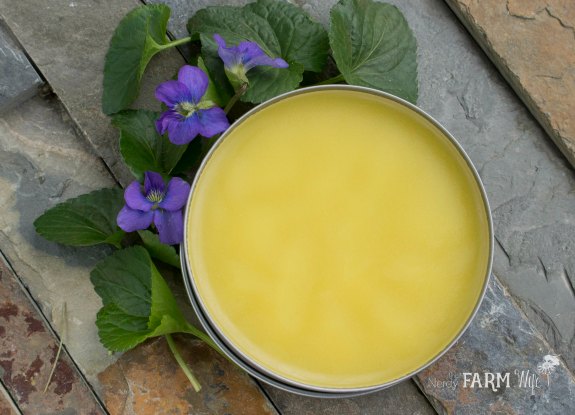
2. Violet Leaf Balm/Salve
Violet leaf infused oil makes this balm extra soothing, moisturizing, and toning.
It’s helpful for eczema, minor scrapes, rashes, and as a general skin-smoother.
Violet leaf balm (or salve) may also be helpful for treating fibrocystic breasts.
Find the full recipe and more details in my article: Violet Leaf Balm.
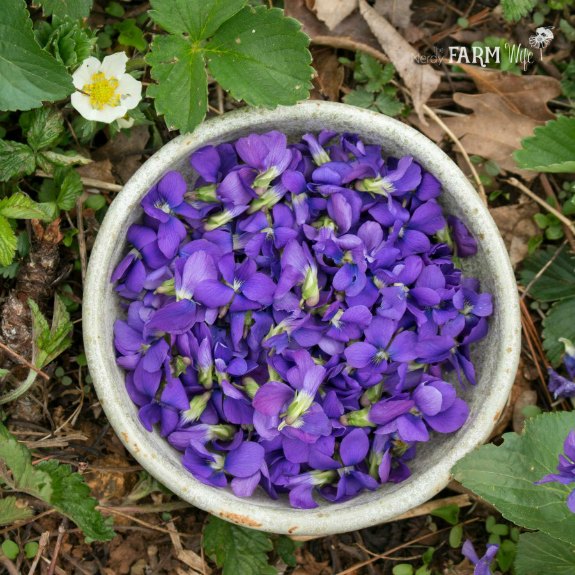
3. Violet Leaf Lip Balm
This extra soothing lip balm is perfect for those with chapped or dry lips.
You an also use it as an every day lip balm, to keep lips soft and protected.
To make, you’ll need:
- 3 1/2 tablespoons violet leaf (or leaf and flower) infused oil
- 1/2 tablespoon castor oil
- 1 tablespoon shea or mango butter
- 1 tablespoon beeswax pastilles
- 5 to 10 drops peppermint essential oil, optional
Combine the infused oil, castor oil, shea butter, and beeswax in a heatproof container or jar. (Use a clean empty tin can for easiest cleanup.)
Place the jar or container down into a small saucepan containing a few inches of water.
Heat the pan over a medium to medium-low burner until the wax is completely melted.
Pour into tins.
This lip balm is designed to be applied with your finger. If pouring into tubes, try decreasing the amount of oil by 1/2 to 1 tablespoon for a firmer texture.

4. Violet Infused Aloe
This soothing gel can be rubbed over mild irritations such as sunburn, bug bites, rashes, dry skin, razor burn and minor scrapes.
You can also incorporate it into lotion and cream recipes.
It’s super easy to make too!
You can find the full recipe and how to make it over at Learning and Yearning.
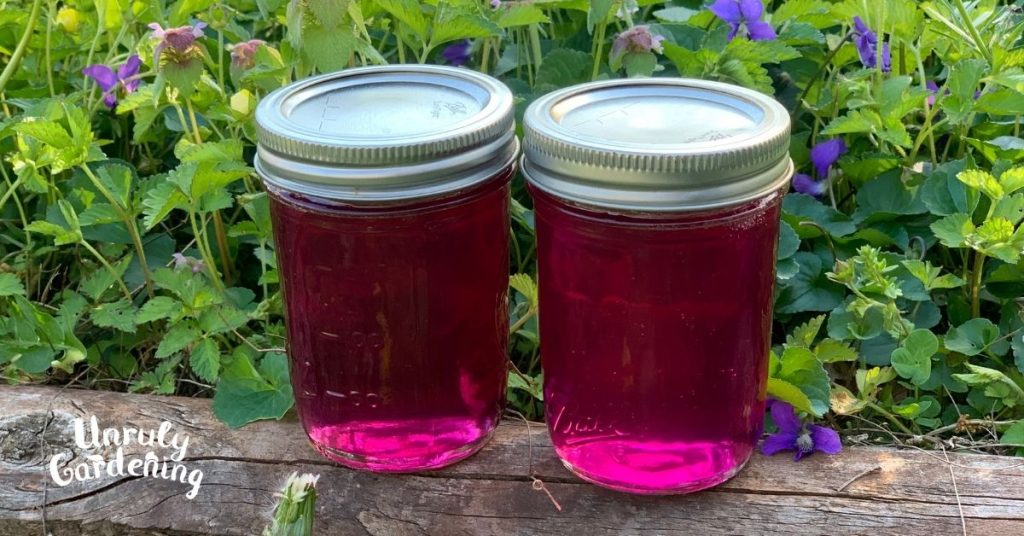
5. Violet Jelly
For this easy to make yummy jelly recipe, you’ll need:
- 2 cups fresh violet flowers
- 3 cups boiling water
- 2 tbsp lemon juice
- 2 1/2 cups sugar
- 1 package low sugar needed Sure-Jell pectin. (the 1.75 oz pink box)
The finished product is delicious with a taste similar to grape jelly.
You can find the recipe and directions to make violet flower jelly HERE, at our family’s site, Unruly Gardening.
Note: While violets are generally mild and safe for most people, if you have medical concerns about using them, check with your health care provider for advice. Violets have a mild laxative effect, so consume in moderation!

6. Violet Vinegar
Violet vinegar is not only beautiful to look at, it’s really useful too!
Here are 5 ways to use it:
- Vinegar baths
- Wasp stings
- Sunburn
- Hair rinse
- Violet vinaigrette
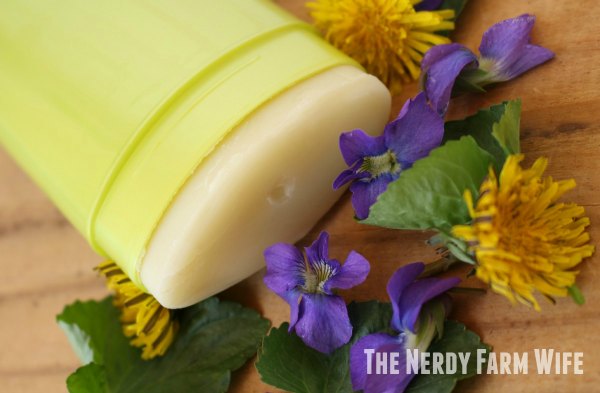
7. Herbal Deodorant for Women’s Health
This homemade deodorant was designed especially for women.
It contains herbs, such as violets, that are used to promote lymph flow and prevent or treat issues with inflamed or cystic breast tissue.
Instead of applying a chemical laden, potentially toxic-to-your-breasts product under your arms each day, try this healthy herbal alternative instead!
Find the full recipe and directions to make over at my article: DIY Herbal Deodorant for Women’s Health.
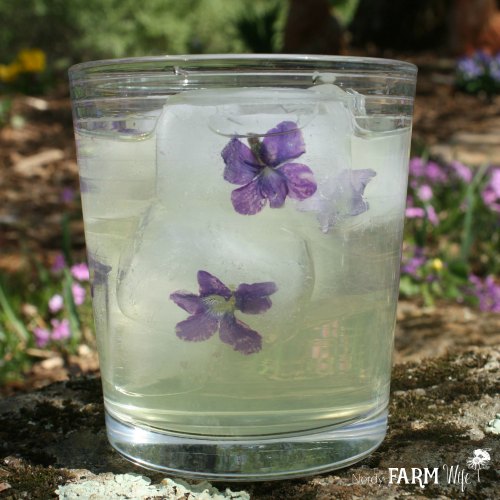
8. Violet Ice Cubes (or Salad Toppers)
Dress up your spring lemonades and other beverages with pretty violet flower ice cubes.
To make:
- Fill an ice tray about half way with water.
- Place a fresh violet flower or two in each section of the tray.
- Pop in the freezer and freeze until almost solid, then fill the rest of the tray with more water.
- Freeze until completely solid.
You can also sprinkle violet flowers in salads, to add a pretty colorful touch!
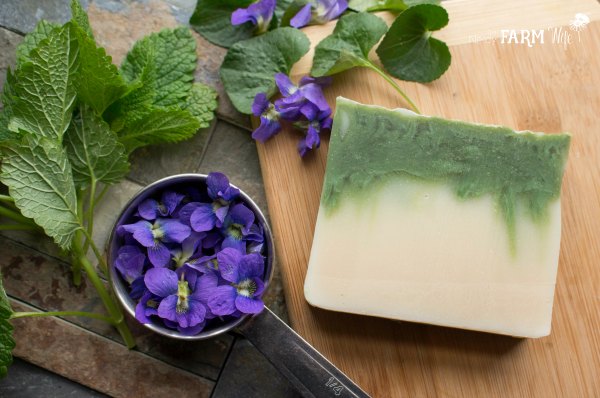
9. Violet Soap
This lovely soap is made with violet leaf infused olive oil and colored a pretty natural green with chlorella powder.
Violets are excellent to use in skin products such as soap, especially if you have dry, irritated, or eczema prone skin.
(For more soap inspiration, check out my Simple & Natural Soapmaking print book!)
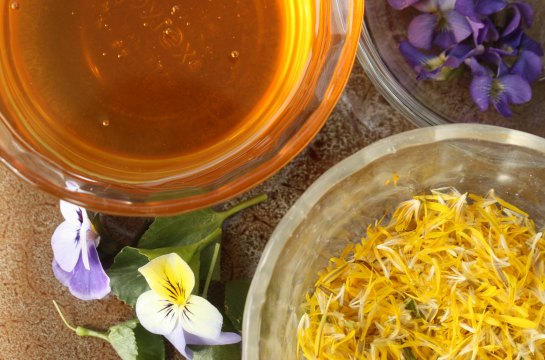
10. Spring Tonic Honey
This spring flower infused honey is a wonderful nutritious treat for you, both inside and out!
You can use it for:
- Seasonal allergies
- Detoxing
- Face wash
- Minor wounds and burns
- Sore throat
Find the recipe and more information in my article, Spring Tonic Honey {with dandelions & violets}.
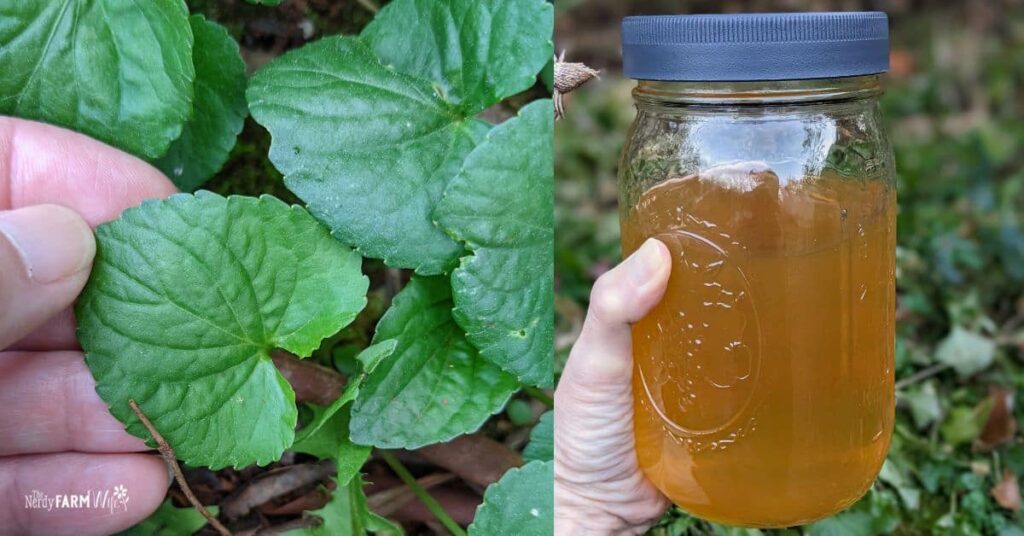
11. Violet Leaf & Honey Syrup
Violet leaves can be used to make a super gentle cough syrup for mild throat irritations and coughs.
Find out how to make this yummy home remedy HERE.
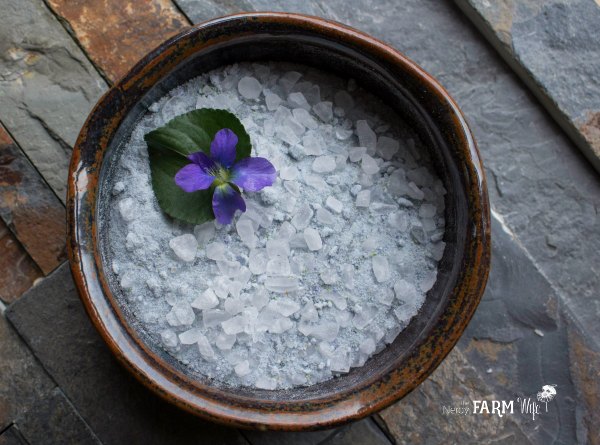
12. Violet Flower Bath Soak
To make this lovely naturally colored bath soak, combine 1/4 cup fresh violet flowers with 1/2 cup sea salt in a mini food processor (like THIS ONE).
Blend well and spread in a thin layer over a sheet of wax paper to air dry overnight.
The next day, crumble the clumps of dried purple salt into a jar and mix with another 2 to 3 tablespoons of extra coarse sea salt or Epsom salts.
If desired, add 4 drops of an essential oil, such as lavender or clary sage for scent. Stir well.
To use, dump the bath soak into a tub as it fills with comfortably warm water. Note that your bath water may turn a pale shade of purple, depending on how many violets you use, but it won’t stain your tub.



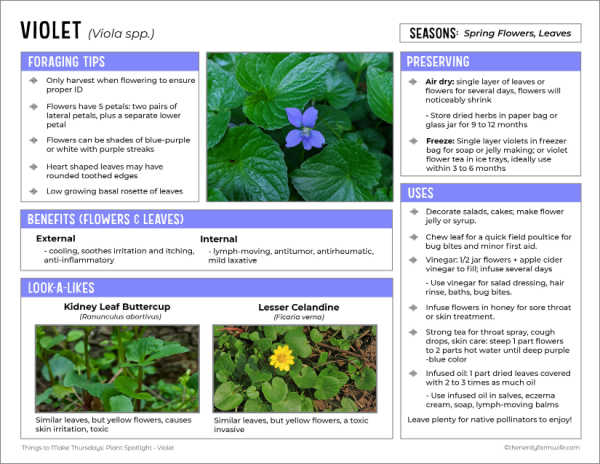

I love this information. Mr father would transplant violets and refused to all them. My yard is full of these gems. So now I have some good ways to use them. Thanks
How wonderful that he did so! Glad that you enjoyed reading about some ways to use your trove of violets! :)
We have a lot of what I’ve always assumed is wild violets, many grow under our raspberry patches. Is there anything else that is a look alike plant, that could be dangerous? I would love to utilize these pretty flowers into some of these recipes here. Thank you!
Hi Donna! I’m not aware of any look-alikes in my area (Virginia), but you could double check with an extension agent in your area to see if they know for sure.
Here’s a site with more photos to help you identify:
http://www.ediblewildfood.com/wild-violet.aspx
http://fbhh.org.uk/wp-content/uploads/2014/04/A-Guide-to-Common-Violets.pdf
http://www.wildflowers-and-weeds.com/Plant_Families/Violaceae.htm
There is one but the flowers are yellow. They just have the same leaves so be careful if they haven’t bloomed yet.
I noticed that it’s best not to use African violets. Is it best to use a particular violet for recipes? There are so many different types that even pansies and Johnny-jumps are considered in the viola family. Do you know the difference in preference, or is there only one type that you use?
Hi Allayna! Anything in the viola family is safe to use, though Viola odorata are usually favored for their medicinal properties. (You’re exactly right that African violets aren’t true violets and aren’t in the viola family.) For body care projects though, pansies and Johnny-jump-ups will both work great too! :)
Jan, I have so many violet plants. Can I use fresh violet leaves to infuse the oil or is there an easy way to dry them. I want to make the soap now.
Hi Margaret! I’ve infused oil with wilted plants (dried just overnight or for an afternoon) before for just for soapmaking. That tiny bit of extra moisture in the oil shouldn’t impact the soapmaking process. Then you could use dried violet leaves to make infused oils for longer storage. :)
Could I infuse some violet flowers with the leaves?
Hi Iris, You sure can! :)
Violets are in bloom now, but I can’t make jelly at the moment. Can I dry flowers in the dehydrator and use for jelly later?
Hi Rebecca! When I can’t make violet jelly right away, I either freeze the flowers to use later, or I make the violet flower infusion for the jelly recipe and then freeze that to make the jelly later in the year. Both ways work! :) I haven’t tried making jelly from dried violets though, so not 100% sure how that would go.
When my daughter was tiny she had cradle cap. It lasted on & off (mostly on) until she was 3. I tried several different natural products, but to no avail. Finally I made some violet oil (I believe I used sunflower oil), rubbed it into those spots a couple times, and it was gone for good. Amazing stuff!
Hi Kristen, Thanks for sharing! That’s wonderful to hear how helpful the violet infused oil was for cradle cap!
Is there a natural perfume spray you can make from the violets? I know when I have made the violet water for my jelly it smells so wonderful I want to use it like rose water.
Hi Geneen, That’s not something I’ve tried to make yet, but I love the idea!
The violets around here are unscented, but last year I bought some sweet violet plants, plus have some started from seed, so hopefully in a few years, I’ll have a bunch so I can experiment with that more. ?
Could I infuse Dandelions & Violets in oil together, and then use that to make soap ?
Hi Sarah, Yes, you sure can! You can infuse your soapmaking oils with all kinds of herbs, or combinations of them. :)
I love this! Thank you so much! My daughter liked the bath salt one because it was easy and didn’t require too many flowers- it inspired her to start a small buisiness and she now is getting ready to sell jars of violet bath salt!
Hooray! I’m so happy that you and your daughter enjoyed the information. I hope she has wonderful success in her business ventures! <3
Can I use Pansies for body products? I want to infuse them into oils. And use a few to decorate the top of products.
Hi Debbie, Yes, you sure can! Pansies are cousins to violets. While our modern pansies don’t have the same strong herbal characteristics as violets, they do have some overlapping uses.
Pansies are great in body care products & make lovely decorations too. :)